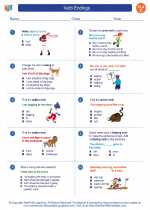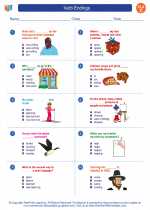Verb Endings
Verbs are action words that show what someone or something is doing. In English, verbs change their form depending on the subject and the tense of the sentence. One important aspect of verbs is their endings, which can indicate the tense, number, and person of the subject.
Verb Endings for Tense
Verbs can have different endings to show the tense of the sentence. For example:
- Present Tense: The verb "jump" becomes "jumps" for third person singular subjects (he, she, it).
- Past Tense: The verb "walk" becomes "walked" to show an action that already happened.
- Future Tense: The verb "play" remains the same, but we can add "will" to indicate a future action, such as "will play."
Verb Endings for Number and Person
Verbs also change their endings to match the number (singular or plural) and person (first person, second person, third person) of the subject. For example:
- Singular: The verb "run" becomes "runs" for a singular third person subject (he, she, it).
- Plural: The verb "walk" remains the same for plural subjects (we, you, they).
Study Guide
To master verb endings, it's important to practice identifying and using verbs in different tenses, numbers, and persons. Here are some study tips:
- Review the different verb tenses (present, past, future) and their corresponding endings.
- Practice conjugating regular verbs in different tenses and for different subjects (I, you, he/she/it, we, you, they).
- Identify and underline verbs in sentences to understand how they change based on the subject and tense.
- Use verb ending worksheets and exercises to reinforce your understanding of verb endings.
Remember, understanding verb endings is essential for constructing grammatically correct sentences and effectively communicating in writing and speaking.



